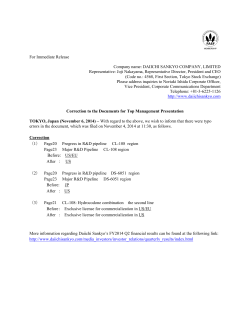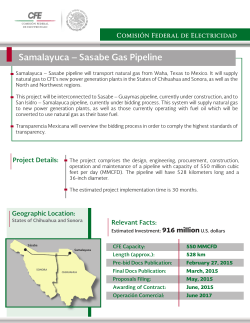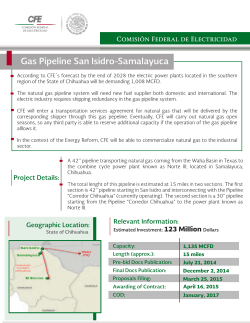
Malaysian Journal of Civil Engineering
Malaysian Journal of Civil Engineering 27(1):162-167 (2015) TECHNICAL NOTE INFILL MATERIALS OF EPOXY GROUT FOR PIPELINE REHABILITATION AND REPAIR S.N.A. Azraai, K.S. Lim, N. Yahaya* & N.M. Noor Department of Structures and Materials, Faculty of Civil Engineering, Universiti Teknologi Malaysia, 81310, Skudai Johor, Malaysia. *Corresponding Author: nordiny@utm.my Abstract: The oil and gas industry uses carbon steel pipelines as the basic element in transporting crude oil and gas. These pipelines are subjected to deterioration due to several factors, including third party damage, material and construction defects, natural forces and corrosion. Deterioration of underground pipelines due to corrosion can lead to serious pipeline failures such as leakage and explosion. Hence, methods to repair such damage have been developed in order to extend the durability of pipelines. This paper reports on the current development of infill materials of epoxy grouts used for pipeline external repair. Assessment of the defects should be completed by pipeline operators to identify list of parameters including pipeline operating characteristic, geometries and materials of pipeline, and configuration and location of pipeline to make the best option of repair techniques. Therefore, selection of an appropriate rehabilitation system is crucial in preventing the future failure of pipeline structure. A simple guideline is required to optimize the information in the selection of suitable materials for pipeline repair works. The selection of suitable materials will help in preventing the future failure of pipeline structures due to inappropriate selection of infill materials. Keywords: Pipeline, epoxy grout, infill materials, deterioration, repair and rehabilitation 1.0 Introduction Steel pipelines are the most efficient and the safest ways to transport natural resources like oil and gas over long distances. According to Central Intelligence Agency (2013), there are over one million kilometers of pipelines laid around the world and more new pipelines are expected to be installed in the future. However, steel pipes that are laid underground can go through an adverse deterioration in the form of corrosion, crack, wearing, buckling, gouging, leaks and rupture. Corrosion and metal loss are the most susceptible weaknesses of steel pipe (Francis, 1994; Frankel, 1998; Noor et al., 2008 & 2010; Yahaya et al., 2011; Narayanan and Sohaimi, 2013). A corroded pipeline will reduce the strength and eventually reduce its service life. Hence, corrosion and metal All rights reserved. No part of contents of this paper may be reproduced or transmitted in any form or by any means without the written permission of Faculty of Civil Engineering, Universiti Teknologi Malaysia Malaysian Journal of Civil Engineering 27(1):162-167 (2015) 163 loss cause failures in pipelines and their repair techniques is one of the prime interests of the researchers all over the world (Shamsuddhoha et al., 2013a). 2.0 Epoxy Grout To date, continuous efforts are put by numerous institutions and companies to develop their very own R&D and commercial composite repair products. Although the products made by different companies and research institutes world widely have different performance from each other, its composite material repair system mainly includes three parts: (i) high strength glass fiber or carbon fiber reinforcing materials; (ii) adhesive materials with high curing speed and high performance; and (iii) high compressed strength material for pipeline defects filling that conveys the load (Ma et al., 2011). Figure 1 shows basic components in composite repair system: (1) Fiber-reinforced polymer (FRP sleeve), (2) interlayer adhesive, and (3) grout. Figure 1: 1-FRP Sleeve; 2-Interlayer Adhesive; and 3-Grout. According to ISO/TS 24817, infill material is defines as the material used to repair surface imperfection prior to the application of composite sleeve (ISO, 2006). Grouts and “putty” are commonly used infill materials. These materials are generally made of epoxy resin. Metal or mineral fillers are used to modify the mechanical, curing and shrinkage properties of the infill. The concept is filled the defect area and provides a smooth surface between composite sleeve and pipe. 164 Malaysian Journal of Civil Engineering 27(1):162-167 (2015) In case of material loss either by corrosion or gouging, grout or putty is used to ensure a smooth bed for the composite layer. The grout is to provide a continuous support by the introduced infill layer that can minimise the radial deformation and transfer the load from pipe to the outer shell. The load, e.g. internal pressure carried by pipe at the repaired segment will be conveyed and shared by outer composite sleeve through infill material. The composite is the primary load carrying component in the repair segment while infill material serves as important bridge to provide a smooth load transfer. Figure 2 shows a simplify illustration of the load transfer in the system. Figure 2: Load transfer mechanism (Source: Freire et al., 2007). 3. 0 Properties of Epoxy Grout In FRP repair system, the properties of grouts are significant parameters which are required in the prediction of the behaviour of a repair system for an optimum design. Therefore, it is crucial to characterize the mechanical and thermal properties to determine their efficiency as infill materials in the repair. A technical insight into an epoxy-grouted hot tap fittings technology for pipeline repair was described by Vu et al. (2011) where the compressive, tensile and flexural strengths specified in that article were 75, 23 and 50 MPa, respectively. Duell et al. (2008) used an epoxy based grout and epoxy wetted flexible carbon wrap to repair the pipes, which had undergone 50% thickness losses on the asymmetric and localised defects. In that study, both numerical and experimental results showed that the grout will be subjected to compressive stress of about 33 MPa when the system is at a pressure of 44 MPa. In another study, Mattos et al. (2009) investigated with an alternative repair system using two grout systems: silicon steel alloy filled polymers and oligomers, and epoxy Malaysian Journal of Civil Engineering 27(1):162-167 (2015) 165 resins with aluminum powder. The compressive strengths of the above materials were 56 and 104 MPa while tensile strengths were 59 and 67 MPa, respectively. Polyester based infill materials were found to be suitable by Sirimanna et al. (2012) for deteriorated piles and the compressive strength was found within the range of 40 to 90 MPa. Shamsuddoha et al. (2013b) carried out the characterization of five commercial epoxy grouts and reported three of it has the potential to be used as infill material. Even though several properties have been investigated in previous works, shrinkage effects on thickness of infill materials did not considered. Polymer can shrink during curing (Li et al., 2004; Haider et al., 2007). Resin when used in thick sizes can experience residual stresses and thus affect the load transfer performance. According to ASME PCC-2 (2006), the service temperature of a repair component of non-leaking and leaking pipes should not be 20oC and 30oC less than the glass transition temperature (Tg), respectively. Moreover, an evaluation of their thermal properties of the components of the repair is also important, as polymers exhibit degradation at elevated temperature. However, detail characteristics of the infill material were left out in the previous works, thus demand additional investigation for better understanding the mechanical and thermal properties of epoxy grouts (Shamsuddoha et al., 2013a). 4.0 Evaluation of Epoxy Grout for Pipeline Rehabilitation and Repair Mendis (1985) state that all the tested grouts having a compressive strength of more than about 40 MPa have the potential to be used in crack repairs. According to Thandavamoorthy et al. (2001), a high performance grout with the compressive strength of 85 MPa is suitable to rehabilitate fatigue damaged tubular joints. Thus, epoxy grouts with compressive strength within this range have the potential for composite repair of steel pipelines. In addition, the tensile and flexural loads are also the governing forces in a pipe repair. The dominant force in a pipe repair is circumferential load which acts as a tensile stress along the hoop direction in the components of the repaired section. Table 1 shows the relevant mechanical properties suggested for different range of repair and rehabilitation works. Therefore, the selection of the grout should be based on the suitability of the properties of the grouts in in situ applications. Table 1: Typical properties of epoxy grout for repair and rehabilitation (Mendis, 1985) Applications Bonding dissimilar materials Concrete crack repair Structural rehabilitation Foundation and heavy machinery applications Compressive strength (MPa) Tensile strength (MPa) Bond strength (MPa) - 10 - 55 7 – 35 41 - 97 83 - 97 14 - 55 28 - 48 14 – 35 28 – 41 ≥97 - 15 - 28 166 5.0 Malaysian Journal of Civil Engineering 27(1):162-167 (2015) Conclusion Most of the R&D and commercially available composite repair systems consist of composite sleeve, adhesive and infill material of epoxy grout to offer great advantages in strength. Based on the preceding researches, it is possible to identify the properties needed for infill materials which are compatible with other repair elements. The mechanical and thermal behaviour of the grouts will aid in understanding the suitability of the properties of the grouts in in situ applications to repair damaged pipeline. Although few researchers have investigated some properties of the commercialized infill materials, the works are mainly focused on the mechanical properties such as compressive and tensile strength (Duell et al., 2008; Mattos et al., 2009; Sirimanna et al., 2012; Shamsuddhoha et al., 2013b). In addition to the existing pipeline design codes and standards, there is no clear guideline and standards of the required properties of infill material according to the type and severity of damage. It is important to compile systematically the properties of infill material as a practical guideline to improve the efficiency of repair works by having a right selection of infill material according to operational condition and the defects. New research with significant impact on the advancement of composite repair technology for damaged steel pipeline is vitally required. By bringing all of the general requirements within one single document, the pipeline industry can recommend to pipeline operators the minimum requirements in the selection of infill material of epoxy grouts as part of the composite repair system to repair deteriorating pipelines. References ASME International. (2006). ASME PCC-2-2006. Repair of Pressure Equipment and Piping. New York, USA: The American Society of Mechanical Engineers. Central Intelligence Agency. (2013). The World Fact book Field Listing: Pipelines, accessed on 26 October 2013, https://www.cia.gov/library/publications/the-worldfactbook/fields/2117.html. Duell, J.M., Wilson, J.M., and Kessler, M.R. (2008). Analysis of a Carbon Composite Overwrap Pipeline Repair System. International Journal of Pressure Vessels and Piping. 85, 782788. Francis, R. (1994). Galvanic Corrosion of High Alloy Stainless Steel in Sea Water. British Corrosion Journal. 29(1), 53-57. Frankel, G.S. (1998). Pitting Corrosion of Metals: A Review of the Critical Factors. J. Electrochem Soc. 145, 2186-2198. Freire, J.L.F., Vieira, R.D., Diniz, J.L.C., and Meniconi, L.C. (2007). Effectiveness of Composite Repairs Applied to Damaged Pipeline. Experimental Techniques., September/October, 59-66. Haider, M., Hubert, P., and Lessard, L. (2007). Cure Shrinkage Characterization and Modelling of a Polyester Resin Containing Low Profile Additives. Compos. A: Appl. Sci. Manuf. 38, 994-1009. Malaysian Journal of Civil Engineering 27(1):162-167 (2015) 167 ISO. (2006). ISO/TS 2481. Petroleum, Petrochemical and Natural Gas Industries – Composite Repairs of Pipework – Qualification and Design, Installation, Testing and Inspection. Switzerland: International Organization for Standardization. Li, C., Potter, K., Wisnom, M.R., and Stringer, G. (2004). In-situ Measurement of Chemical Shrinkage of MY750 Epoxy Resin by a Novel Gravimetric Method. Compos. Sci. Technol. 64, 55-64. Ma, W.F., Luo, J.H., and Cai, K. (2011). Discussion about Application of Composite Repair Technique in Pipeline Engineering. Advanced Materials Research. 311313, 185-188. Mattos, H.S.d.C., Reis, J.M.L., Sampaio, R.F., and Perrut, V. (2009). An Alternative Methodology to Repair Localized Corrosion Damage in Metallic Pipelines with Epoxy Resins. Materials and Design.30, 3581-3591. Mendis P. (1985). Commercial Applications and Property Requirements for Epoxies in Construction, SP. ACI Special, 127-40. Narayanan S.P. & Sohaimi A.F.A (2013), Ultimate Strength Assessment for Fixed Steel Offshore Platform, Malaysian Journal of Civil Engineering, 25 (2), pp.128-153 Noor N.M., Yahaya N. and Othman S.R. (2008), The effect of extreme corrosion defect on pipeline remaining life-time, Malaysian Journal of Civil Engineering, 20 (1), pp. 47-57 Noor N.M., Yahaya N., Ozman N.A.N and Othman S.R. (2010) The forecasting residual life of corroding pipeline based on semi-probabilistic method, UNIMAS e-Journal of Civil Engineering, Vol.1, pp.246-263 Shamsuddoha, M., Islam, M.M., Aravinthan, T., Manalo, A., and Lau, K.T. (2013a). Effectiveness of Using Fibre-Reinforced Polymer Composites for Underwater Steel Pipeline Repairs. Compos. Struct., 100,40-54. Shamsuddoha, M., Islam, M.M., Aravinthan, T., Manalo, A., and Lau, K.T. (2013b). Characterization of mechanical and thermal properties of epoxy grouts for composite repair of steel pipelines. Material and Design, 52,315-327. Sirimannaa, C.S., Lokugeb, W., Islamc, M.M., and Aravinthand, T. (2012). Compressive Strength Characterization of Polyester Based Fillers. Advanced Materials Research. 410, 32-35. Thandavamoorthy, T.S., Madhava Rao, A.G., and Santhakumar, A.R. (2001). Development of a fly ash and epoxy based high-performance grout for the repair of offshore platforms, vol. 199. ACI Special Publication. Vu, D., Glennie, A. and Booth, P. (2011). Pipeline Repairs and Hot Tapping Technologies Using Epoxy Based Grouted Technology. 6th International Offshore Pipeline Forum, 19-20. Yahaya N., Lim K.S, Noor N.M.., Othman S.R. and Abdullah A. (2011), Effect of clay and moisture content on soil corrosion dnamic, Malaysian Journal of Civil Engineering 23 (1), pp. 24-32.
© Copyright 2025









